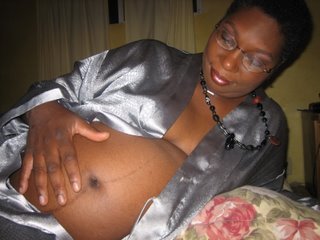I made the recent decision to become a lactation consultant. In 2012 the required criteria will change to become more stringent. I decided now was my chance to do it. I had most of the requirements already, save one. I need 500 hours of clinical time with a lactation consultant, following her, learning her trade. I need to complete those 500 hours in six months, the deadline for the lactation consultant exam. That's 80 hours a month, 20 hours a week, to eek out of my already packed schedule. I'm up for the challenge. I had my first full day last week with Charlene Burnett, a long time friend and lactation consultant. In one eight hour day, I followed Charlene as she taught two breastfeeding classes, one to inpatients, and one to outpatients. She was called to the pediatric clinic twice to do on the spot consultations with moms having breastfeeding troubles. She did morning and afternoon rounds on all the breastfeeding inpatients, consulted constantly with the staff nurses on their patients' status, and conferred with the quality improvement nurse on gathering breastfeeding statistics to document all her efforts. She also oriented me to the unit, processes, procedures, and culture of the floor. I've know Charlene for many years, but I've never seen her in her element. She was like poetry in motion, zipping from one place to the next, swooping in to save the day (or sore nipples as the case may be) her white coat standing in as her superhero cape. It was all so impressive seeing an expert, high functioning lactation consultant at work. I was actually brought to near tears, as I watched her work with an African-American young mother back in the Pediatric clinic with her week old infant. The young woman's mother hovered near by taking in every word, with a look of concern for both her daughter and infant grandson. Charlene asked the young woman questions to gauge her concerns, then asked to see her breastfeed her son. Charlene watched the woman nurse for a minute or so and asked more questions. The entire time in a low soothing tone, she also spoke to the infant, giving information about breastfeeding basics (of course this information was intended for the mother and grandmother, though she was addressing the infant- very cute). After asking permission to touch the woman's breast (as she was careful to do all day with every patient), she showed the woman how to more effectively position both her breast and her baby to prevent sore nipples. She had immediate positive results and you could see the relief on both the mom and grandmother's faces. She ended the visit with a few positive encouraging words. The entire visit was no more than 10 or 15 minutes, and yet this young mother had turned a corner. I had no doubt that that short visit would reap benefits in keeping this mother nursing her baby for a longer duration. She was more confident and empowered than the worried, anxious mother we had met when we entered the room. Charlene had even convinced the skeptical grandmother that her daughter could give her grandson adequate nutrition. Leaving the room with mother and baby happily nursing, we stopped at the desk for Charlene to give her report to the pediatrician. She explained in a few words what the problem had been and the tools she gave the mother to manage the situation. The pediatrician looked at her with gratitude and relief, and thanked her. She garnered respect from all her peers, it was clear that everyone saw the value in the service she offered. We quickly moved on to the next task at hand. During the outpatient class, three new moms sat around a table nursing their babies of varying ages and chatting excitedly about how their breastfeeding had evolved from the previous week. After each mom had shared, Charlene asked about their difficulties and then worked with each mom individually on her particular nursing issue while I chatted with the others about their baby's progress and development. She ended the class by giving each mom a gift before sending them on their way. (She had written a grant and used the money to purchase breast pumps, nursing pillows, fancy burp blankets, etc.) Later that same day, I watched as Charlene gave instructions to a Latina patient in Spanish (!) on getting her newborn on the breast. I loved getting an up close personal view on the impact an LC can have on the families she serves and her work environment.
Though I have no plans to work in the hospital setting, I'm looking forward to being able to provide this level of guidance and assistance to those who need it. My plans for my LC credential include educating staff nurses on breastfeeding basics, and breastfeeding supportive behaviors, and creating research to measure educational effectiveness for nurses. My research and experience has shown me that staff nurses in labor and deliver, nursery, or mother/baby are often the weakest link in the breastfeeding support chain. I'd like to dedicate my efforts to strengthening that link.























